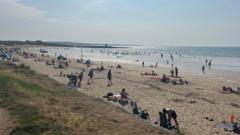Is Wales Facing a Double Heatwave This Week?

Understanding the Increasing Frequency of Heatwaves in Wales: A Comprehensive Overview
The weather patterns in Wales are undergoing significant changes, with the country experiencing unprecedented heatwaves. This week, regions like Monmouthshire are bracing for temperatures soaring up to 33°C, marking the third heatwave of the year. As we delve into the implications of these temperature spikes, we will explore how climate change is influencing weather patterns, safety measures for coastal visitors, and what this means for the future of Welsh summers.
The Current Heatwave: What to Expect
Wales is currently under the influence of a heatwave that is not only unusual but also serves as a stark reminder of climate change. The forecast for the week indicates that temperatures may reach highs of 33°C on Tuesday, a temperature that has only been recorded five times in August since data collection began in 1930. Previous instances occurred in 1990, 1995, 2003, 2020, and 2022. As weather presenter Sabrina Lee notes, this trend towards hotter summers is likely to continue as climate change accelerates.
The Role of Climate Change in Weather Patterns
Climate change is reshaping the world around us, and Wales is no exception. As global temperatures rise, we can expect summers to become hotter and drier, with heatwaves becoming more frequent. This shift in climate not only impacts daily life but also raises concerns regarding health, agriculture, and the environment.
Implications for Coastal Areas
The hot weather has prompted safety warnings from organizations like the RNLI (Royal National Lifeboat Institution). The combination of high temperatures and large tides can pose significant risks to coastal visitors. Here are some essential safety tips to keep in mind:
- Always check tide times before heading to the beach.
- Carry a fully charged mobile phone for emergencies.
- Opt for lifeguarded beaches when swimming.
- Swim between the red and yellow flags, which indicate safe zones.
Understanding Tides in Wales
Wales is home to one of the largest tidal ranges in the world. This geographical feature means that the tides can rise and fall dramatically, often catching unaware visitors off guard. Porthcawl lifeboat crew member Chris Page emphasizes the importance of checking tide times from reliable sources like the Met Office to avoid dangerous situations.
Heatwaves and Their Impact on Daily Life
The rising temperatures during heatwaves can lead to various effects on daily life in Wales. From health risks to economic impacts, the repercussions of extreme heat are widespread and require proactive measures from both individuals and communities.
Health Risks Associated with High Temperatures
Heatwaves pose several health risks, particularly for vulnerable populations such as the elderly, children, and those with pre-existing health conditions. Common health issues during extreme heat include:
- Heat exhaustion and heat stroke
- Dehydration
- Worsening of cardiovascular and respiratory conditions
Economic Effects of Heatwaves
Extreme weather can also have economic implications. For example, heatwaves can affect agriculture by leading to crop failures or reduced yields. Additionally, increased energy demand for cooling can strain local resources and lead to higher utility bills. Businesses that rely on outdoor activities may also face a decline in customers during extreme heat, impacting their bottom line.
Preparing for Future Heatwaves
As we move forward, it is crucial to prepare for the likelihood of more frequent heatwaves. Communities, governments, and individuals all have roles to play in mitigating the impacts of extreme heat.
Community Initiatives
Local governments can implement community initiatives such as:
- Creating more green spaces to reduce urban heat
- Establishing cooling centers for vulnerable populations
- Running awareness campaigns about heat safety
Individual Preparedness
On an individual level, people can take steps to prepare for heatwaves:
- Stay hydrated and avoid strenuous activities during peak heat.
- Use fans or air conditioning to stay cool.
- Educate yourself about heat-related illnesses and their symptoms.
What Lies Ahead for Welsh Summers?
As the climate continues to change, the question remains: what will the future hold for summers in Wales? It is likely that we will see an increase in the frequency and intensity of heatwaves, which could have lasting impacts on the environment, economy, and public health.
Long-Term Solutions to Combat Climate Change
To mitigate the effects of climate change, long-term solutions must be implemented. These include:
- Reducing greenhouse gas emissions through sustainable practices.
- Investing in renewable energy sources.
- Promoting public transportation and reducing reliance on cars.
Encouraging Community Resilience
Building community resilience is vital in facing climate challenges. Communities can come together to develop strategies that enhance their ability to cope with extreme weather, ensuring that everyone has the resources and support they need during heatwaves.
FAQs About Heatwaves in Wales
What is considered a heatwave in Wales?
A heatwave in Wales is typically defined as a period of prolonged and excessively hot weather, often characterized by temperatures significantly above the average for the region. According to Meteorological standards, this can mean temperatures exceeding 25°C during the day for several consecutive days.
How can I stay safe during a heatwave?
To stay safe during a heatwave, it is crucial to remain hydrated, avoid strenuous activities during peak heat hours, wear lightweight clothing, and seek out cooler environments. Checking on vulnerable friends and family members is also essential.
Are heatwaves becoming more common in Wales?
Yes, due to climate change, heatwaves are becoming more common in Wales. Historical data shows an upward trend in summer temperatures, leading to increased occurrences of extreme heat.
Conclusion
The increasing frequency of heatwaves in Wales is a clear indication of the changing climate. With predictions of hotter and drier summers, it is vital for individuals and communities to prepare for the challenges ahead. By staying informed, taking safety precautions, and advocating for sustainable practices, we can mitigate the impacts of these extreme weather events. As we navigate this new reality, one must ponder: how will we adapt to ensure the safety and well-being of future generations? #ClimateChange #WalesWeather #HeatwavePreparedness
Published: 2025-08-12 11:15:11 | Category: wales



